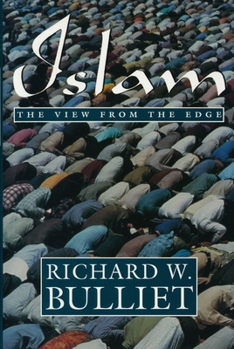Islam View from Edge
Select Format
Select Condition 
Book Overview
Bulliet abandons the historian's habit of viewing Islamic history from the center, that is, focusing on the rise and fall of imperial dynasties. Instead, he derives an understanding of how and why Islam became -- and continues to be -- so rooted in the social structure of the vast majority of people who lived far from the political locus and did not see the caliphate as essential in their lives.
Format:Paperback
Language:English
ISBN:0231082193
ISBN13:9780231082198
Release Date:May 1995
Publisher:Columbia University Press
Length:236 Pages
Weight:1.40 lbs.
Dimensions:0.5" x 6.0" x 8.9"
Grade Range:Postsecondary and higher
Customer Reviews
2 ratings
Islam: A View from the Edge
Published by Thriftbooks.com User , 21 years ago
Islam: A View from the Edge. By Richard W. Bulliet. New York: Columbia University Press, 1994. Pp. 236. [money amount]Islam: A View from the Edge is a socio-historical analysis of the Nishapur Diaspora through the experience of the new converts and their relationship with the ulemas. The aptly titled book is a survey of how Islam developed in the periphery rather than in the center, and how the scholastic developmental patterns in the center were heavily influenced by the creativity in the periphery. He suggests that the edge's creative source was the question-answer motif employed by the converts to learn about Islam. When people converted they would seek out individuals who knew the answers to questions regarding worship. This led to the emergence of individuals who succeeded in gaining the convert's ratification for their interpretive efforts as being the most authentic representations of the divine intent. Such fluid discourse led to the development of local expressions of Islam. Bulliet contends that there was no single legitimate interpretation of Islam but rather many in the early years of Islamic history. Islam was homogenized by the efforts of many Persian ulemas who were expatriates of what is today Eastern Iran. These individuals organized themselves into schools of law around charismatic eponyms which came to be known as madhhabs. Madhhabs would later become the center of all religious interpretive exercises and a source of legitimacy in the Muslim body politic. In particular Bulliet points out the Ashari-Shafi community of Persia that were the most influential consolidators of Sunnism. They spread their rationalistic expression of Sunni Islam via their stock and trade, namely the Madrasa, a quintessential Persian innovation in early Muslim civilization. This group eventually became part of the center and its version of orthodoxy was championed by such figures as Nizam al-Mulk. This form of Sunni Islam was understood by its proponents as the middle path between the excessively rationalistic Mu'tazilites and the overly conservative traditionalist Hanbalites. Nizam al-Mulk commissioned the famous Nizamiyya Madrasas in Tus and more importantly in Nishapur and Baghdad. It was from these schools that the Ash'ari-Shafi'i scholars propagated their doctrines and inserted a type of mythology into the collective memory that the scholastic evolution within Sunni Islam had its end goal their grand synthesis of the text and reason.If there are any criticisms that could be directed at Bulliet's work it is that he stresses the edge disproportionately and effectively gives an impression that the center had no significant role in the development of Islam. Bulliet says the view from the edge is needed because it is the edge that ultimately creates the center (pg. 12). However he becomes too dogmatic in distinguishing between the edge and the center and overlooks their similarity. The development of the center Iraq and the edge Iran/Nishapur have much m
Islam by Richard Bulliet
Published by Thriftbooks.com User , 23 years ago
There is a saying attributed to Prophet Muhammad (pbuh) that 'Disagreement among the scholars is great mercy for mankind'. Taken in this spirit, this work of Professor Bulliet is a great contribution to Islam. There exists very little information about some of the events and development in early muslim history. By looking at what people did write about (like personal biographies) and also some broader social/economic conditions the author is able to make some very surprising conclusions. For a layperson and believing muslim like myself this was a book that was engrossing in what I learn't from it and thought provoking in what questions it raised for me. I am sure that scholars (muslim and non-muslim) studying about Islam would read this book. However I would recommend that any muslim serious about learning of the development of islamic society and traditions would find this work of great value. One does not have to agree with everything in a particular work for it to be valuable. This book has far more to offer any one studying development of islamic societies than any I have read.





